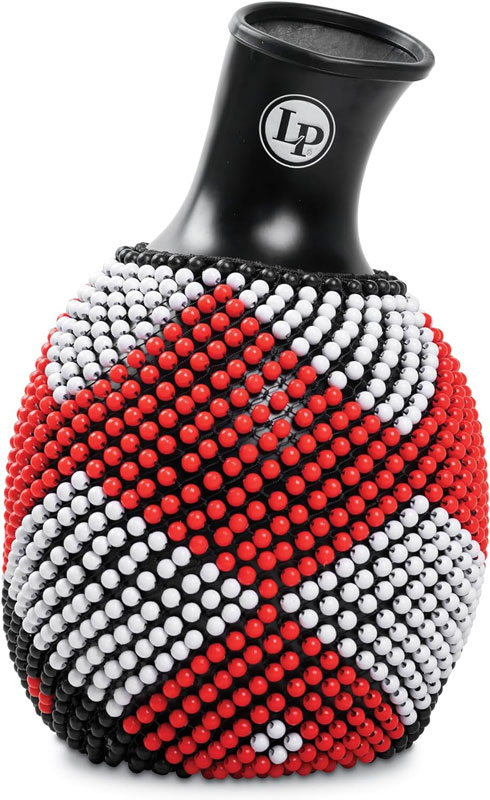(headline image: Latin Percussion shekere, LP486)
The shekere is a percussion instrument made from a dried gourd, covered with a net woven with beads, stones, or cowrie (small sea snails) shells. The instrument produces sound when shaken or struck against the hand. It can also be held in one hand while the other manipulates the gourd using a twisting wrist motion, causing friction between the beads and the gourd, creating a unique sound different from simple shaking or striking.

With regard to its origins and cultural significance, the shekere appeared in the Yoruba region of West Africa, which includes Nigeria, Benin, and Togo. Despite its Yoruba roots, the instrument has spread throughout West Africa and Latin America, becoming integral to the folk music traditions of many cultures. It is widely used in world music, Latin Jazz, and popular music genres.
In Ghana, it is called the axatse, and in Brazil, it is known as the cabaça or xequerê. The instrument goes by various names across different regions, including afuxê, afoxé, cabasa, and cabaza.
Shekeres are typically made from vine gourds, which are left to dry for several months before the pulp and seeds are removed. After cleaning, beads are woven into a net that is fitted around the gourd. The shape and size of the gourd determine the sound of the instrument, and the bead work is often colorful, adding an aesthetic element.
The traditional shekeres feature a round gourd with a handle. Newer variations include shekeres with long, curved handles as well as tubular shekeres which are cylindrical, designed for faster movements and quicker rhythms.
Across Africa, many similar gourd-based percussion instruments exist, including the lilolo, axatse (Ghana), jabara (Guinea), ushàkà, and saa saa (Liberia). The agbe, a gourd drum from West Africa, is typically strung with cowrie shells and produces a distinctive sound. In Liberia, the instrument’s net regularly features a long tail through which the beads are manipulated to create different sounds.
In Cuba, the shekere is known as chekere or aggué. It was adapted from its African roots by using local materials. The Cuban chekeré is a large, hollow gourd, approximately 50 cm long, surrounded by a network of cords with attached colored beads. This instrument can be twisted, shaken, or slapped, allowing for a versatile range of sound effects, more so than simpler percussion instruments like maracas.
When it comes to modern adaptations, shekeres are currently made from a variety of materials beyond the traditional gourd. Modern manufacturers produce shekeres using durable fiberglass, which provides a thicker neck and wide mouth for deep bass tones when struck. The variety of materials and shapes offers musicians more flexibility, with options for plastic, metal, or fiberglass bodies and beads made from various materials.


